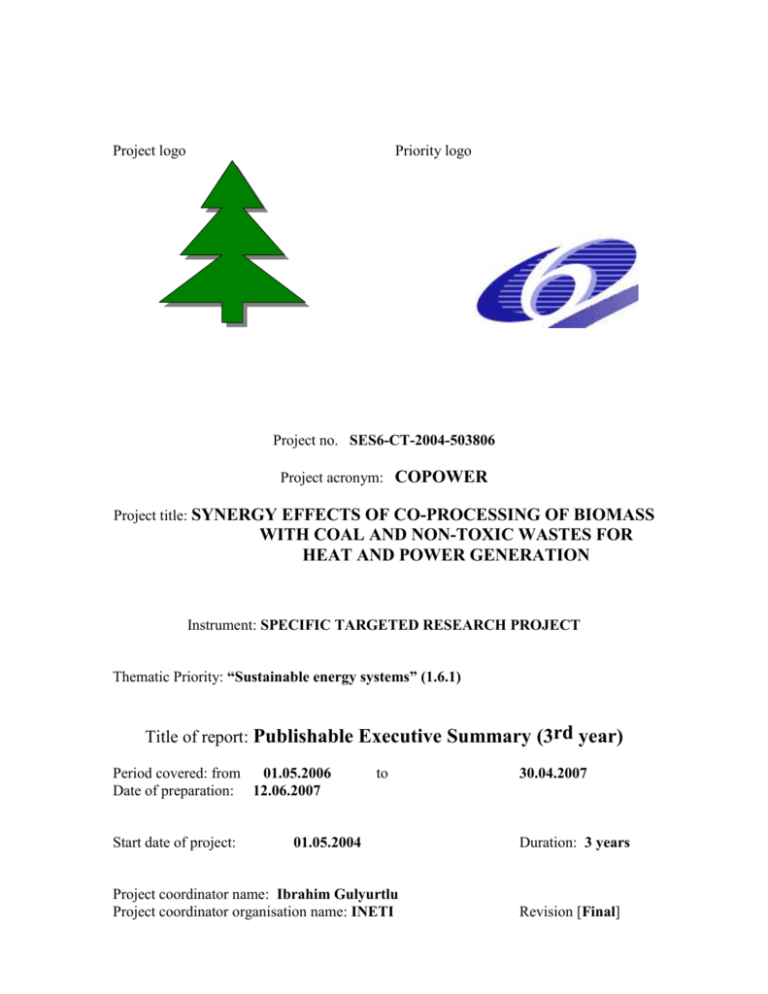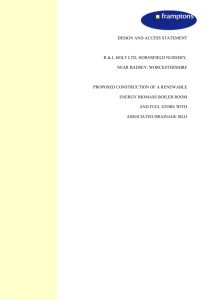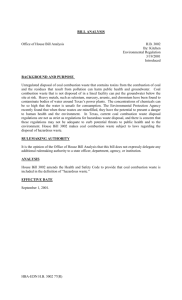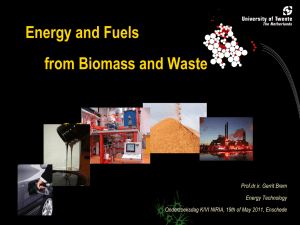Synergy Effects of Co-processing of Biomass with Coal and Non
advertisement

Project logo Priority logo Project no. SES6-CT-2004-503806 Project acronym: COPOWER Project title: SYNERGY EFFECTS OF CO-PROCESSING OF BIOMASS WITH COAL AND NON-TOXIC WASTES FOR HEAT AND POWER GENERATION Instrument: SPECIFIC TARGETED RESEARCH PROJECT Thematic Priority: “Sustainable energy systems” (1.6.1) Title of report: Publishable Executive Summary (3rd year) Period covered: from 01.05.2006 Date of preparation: 12.06.2007 Start date of project: to 01.05.2004 Project coordinator name: Ibrahim Gulyurtlu Project coordinator organisation name: INETI 30.04.2007 Duration: 3 years Revision [Final] Publishable Executive Summary This project aims at determining the limits of the optimized operation that could be beneficial in getting rid of waste and promoting biomass for environmentally acceptable energy generation. Fluidized bed systems are particularly well suited for such a co-firing operation because of their versatility with regard to fuel. To achieve this global aim, the project brought together the following contractors whose contribution to the project are very complementary and experience and know-how are essential for the success of the work undertaken. The contractors are: - Portugal: INETI (R&D Institute from Lisbon), UNL (University from Lisbon) and CARMONA (a waste management company), - Germany: TUHH (University from Hamburg), and SD (Power plant operator from Duisburg), - Sweden: CTH (University from Goteburg), - Italy: UN (University from Naples) and ENEL (Utility company), - United Kingdom: Imperial College (University from London), - Turkey: Sabanci Universitesi (University from Istanbul) The coordinator of the project is INETI and the representative of INETI to do this coordination is Dr. Ibrahim Gulyurtlu Phone nº: +351 21 092 4789; Fax nº: +351 21 716 6569 e-mail: ibrahim.gulyurtlu@ineti.pt The project defined its main objectives that are given below: 1) The evaluation of the biomass resources for three specific countries, namely Portugal, Italy and Turkey. 2) The identification of techno-economic barriers to the utilisation of biomass and other wastes as energy source from either plantation or waste production sites, as energy sources for the three countries. A case study including three countries will be conducted. 3) The analysis of adequate fuel preparation systems to achieve synergy in fuel mixes to be prepared for energy processes. 4) The characterisation of the wastes available to determine their potential for synergy in fuel mixes to be prepared with a particular attention given to reactivity, ash composition and ash fusion point. 5) The understanding of the combustion of fuel mixes in fluidised beds with the aim of determining the limits of optimized synergy for efficiency. 6) The understanding of ash behaviour during the combustion to determine synergy required in the fuel mix preparation to minimize the tendency to slagging and fouling. 7) The determination of the levels of the pollutants resulting from the co-firing system and definition of conditions for synergy of different components in the fuel to minimise the emissions of potential pollutants to the atmosphere. 8) The analysis of ashes produced during co-firing with the aim of their re-utilisation. 9) The socio-economic and environmental impacts of the co-firing technology. 10) Based on the results, the evaluation of co-firing for energy production in an economically acceptable manner by closely analysing the costs involved and the potentials to reduce costs. The project, by achieving these objectives, addresses the issues related to the whole chain of fuel supply for co-firing, optimizing combustion process involving multi-fuels, and ways of optimizing its economic and environmental consequences, in order to overcome the above mentioned barriers. The co-firing tests are carried out using fluidized beds which offer the versatility required to deal with different fuels at the same time. The project started on May 1, 2004. The project is structured into 7 workpackages with the aim of addressing the issues raised in the objectives above. The workpackages are: WORKPACKAGE 1 (WP1) – Fuel supply chain analysis WORKPACKAGE 2 (WP2) – Fuel characterization of biomass and waste materials WORKPACKAGE 3 (WP3) – Co-firing trials aiming at the synergy of different fuels to optimize the plant operation and environmental emissions WORKPACKAGE 4 (WP4) - Environmental impact assessment and socioeconomic assessment WORKPACKAGE 5 (WP5) - Management and optimisation of the whole chain and market analysis WORKPACKAGE 6 (WP6) – Dissemination WORKPACKAGE 7 (WP7) – Co-ordination WP1 was completed at the end of the first year of the project and the global conclusions together with the individual country reports of Portugal, Italy and Turkey were presented in the first report of the project submitted on June 15, 2005. WP2 work was carried out during the second year and a final report was elaborated at the end of the second year and all five tasks during year 2 of the project. A major effort was spent on characterizing all of the fuels selected for the project, principally a set from CTH [based on Polish coal, straw and sewage sludge], plus one from SD [based on Columbian coal plus meat and bone meal plus wood chips]. These fuels were subjected to a whole suite of analyses and a large body of data produced. Subsequent activities focused on assessment of fuel volatility, char combustion and attrition, and ash behaviour using bench-scale equipment. In addition, some raw fuels plus their binary blends have been characterized for their trace element behaviour during simulated fluidized bed combustion conditions. The work on all tasks of Workpackage 3 continued during the third year and was successfully completed. The work was mostly carried out on the pilot plants and the ecotoxicity of ashes in the scope of Task 7. The results obtained from pilot-scale tests were compared with those from the Duisburg plant. During the tests the operating parameters and gaseous emissions were recorded and distributed to the contractors. Similar to tests of last year, fuel and ash samples were taken in order to ensure that all tests of the contractors were made with same fuels and ashes. The theoretical work on technology assessment and the simulating tools was also completed and the ecotoxicological risk assessment of ashes delivered were finalised. The workpackages 4 and 5 were also completed and the environmental and socioeconomic impact of co-firing was studied in detail in WP4 and the most optimised combination was identified. Management and optimisation of the whole chain and market analysis were undertaken in the scope of WP5 and the critical points were identified as: 1. The processes of the different phases are strongly heterogeneous, because the utilities and machines have different characteristics, power and productivity. 2. The type of biomass influences the processes and also the supply chain structure. 3. Storage. This point is critical, especially if it is made either before the transport phase or before the combustion process. There were papers prepared to be as a continuation of efforts for the publication of scientific results obtained and were presented in relevant conferences. Three papers were accepted to the 15th European Biomass Conference and Exhibition – From Research to Market Deployment, held in Berlin, Germany on May 7-11, 2007 and one paper was presented in the Third International Conference on Clean Coal Technologies for our Future held in Sardinia, Italy on May 15-17, 2007. The website of the project is functional where the publishable results are available for consultation. The website address is (www.copowerproject com). The website includes pictures illustrating the work done. Some pictures taken at Duisburg are given below. Some pictures taken during the test campaign at Duisburg plant during the autumn campaign 2005 are given below. A view of the combustion zone in the boiler The probes used during measurements The sludge feeding to the boiler Combustion of particles inside the boiler Some of the equipment used for measurements It is unlikely that a plant would obtain and burn a single waste or biomass for a prolonged period. It is more likely that plant officials would buy or offer to dispose of a number of wastes available to them locally. Therefore, potential problems and synergies arising from the various combinations need to be identified. That is why COPOWER studies different combinations, not only using different coals but also several waste materials which are usually very country specific. In addition, a database is created to get the information about fuels, even those not experimented in the project. The fuels selected reflect the variations in different countries, particularly between the Northern and Southern Europe. In addition, both upstream and downstream impacts are important. Upstream impacts include handling, preparation and storage. The study on this is complete and is currently available. The contribution from SD to this work is very important and relevant because of their experience with plant operation. Downstream ones include ash deposition, corrosion, and pollutants (reliable prediction of SO2 and NOx and reduction in particular, as well as heavy metal emissions). All these issues were studied in detail in the scope of WP3. The results could serve as guidelines to plant operators. The successful application of co-firing depends upon the proper evaluation of the individual fuel and the fuel mixes. With the uncertainties still to be identified and investigated in the CFBC technology for co-firing, COPOWER aims at improving the knowledge to reduce the level of uncertainties so that cost/performance model for CFBC could be improved. In addition, dedicated firing of waste and biomass in multi-fuel systems has yet to be shown to be economic without subsidies or tax breaks or added costs levied on competing sources of power derived from conventional fuel sources. This was done by ENEL in the scope of WP5. Previous co-firing tests, mostly in pulverized fuel combustion systems were undertaken using coal as the base fuel and admitting relatively small amounts of waste or biomass (no more than 10% of thermal input). There are presently two main attitudes to co-firing. One regards coal as the problem, largely due to the quantities of CO2 produced and their enhancement of the greenhouse effect. Co-firing, especially with ‘CO2-neutral’ biomass is a way of displacing coal as a fuel and thus reducing greenhouse gas emissions. A study, undertaken during the execution of this project, analysing the fuel consumption in large-scale power plants has suggested that in energy terms, the substitution of about 10% of coal by mass with biomass with 15% humidity levels could reduce the CO2 released more than 8%, the limit set up in the scope of the Kyoto Protocol. The amount of coal should be kept to minimum necessary to ensure availability of electric power and to minimize any problems encountered in burning biomass alone. The other attitude sees coal as the solution, largely to the increasing problems of waste disposal. Here, the more stable combustion characteristics and the lesser environmental impacts of coal are used to deal with wastes that otherwise would be landfilled or, if incinerated alone, would lead to more undesirable emissions to the atmosphere. In this case, the amount of coal has to be large enough so that any adverse effects of the waste materials are unnoticed. There is a need for a new perspective to be introduced in the context of multi-fuel systems which could avoid the dependence on any one fuel for energy production. COPOWER aims at introducing this concept because the trend in the future has to be with systems operating on multi-fuel mixes. For this reason, combinations of coal, biomass and waste will be tried and early results show that multi-fuel use could lead to overcoming many problems like reducing heavy metal vaporization by the presence of S, Cl etc. This could also have beneficial effect of fixing S, Cl, etc in the ashes rather than their emissions to the atmosphere. Combining high S fuels with high Cl ones could have beneficial effect on suppressing dioxin emissions. The limits have to be well defined to give the operators the flexibility of the mixing different combinations. COPOWER aims at improving the knowledge for fuel blending. From the results obtained, a list is made summarising the positive synergies achieved during co-firing tests and and they are: 1) The addition of sludge changes bed inventory and axial solids distribution and improves heat transfer in upper part of combustion chamber. (finding in large-scale test supported by bench-scale work on fragmentation) 2) Influence of waste addition on dust emissions, yet unclear (possibly agglomeration of fine dust particles or improvement of EP by addition of water). 3) Sewage sludge captures KCl from biomass. 4) Sulphur in coal helps to avoid KCl formation problems. 5) Coal ash helps to avoid KCl formation problems. 6) The ash of sewage sludge may be beneficial in capture of potassium, because it consists partly of zeolites. It forms potassium-aluminia-silicates. 7) Co-combustion of coal, sewage sludge and straw improves retention of six heavymetals in bottom ashes. 9) Co-combustion with waste and biomass reduces NOx-emissions. 10) Co-combustion with low sulphur containing biomass reduces lime consumption 11) No significant change in eco-toxicity and leachability of metals of ashes with cocombustion. 12) Ca-rich waste can reduces the limestone requirement in co-combustion (waste must be low in phosphorous, calcium phosphate is formed). 13) Devolatilization is increased with co-combustion of coal and straw, at the same time temperature of devolatilization is decreased. 14) Co-combustion of coal, sewage sludge and biomass reduces the pressure drop in the combustion chamber and thus the energy requirement. 15) Feeding of biomass reduces the amount of residues (attention must be paid for a sufficient bed inventory). The list giving the negative synergies observed is below: 1) Avoid firing fuels highly loaded with Hg. 2) In case high K-containing fuel its amount has to be restricted in the feed to avoid agglomeration. 3) Negative synergies might occur with heavy metals (e.g. Pb, Zn). 4) The water content in the waste increases the flue gas flow. This may increase the heat loss. 5) For the control of dioxins and furans, it is necessary to have high S/Cl ratio to minimise the emission levels.







